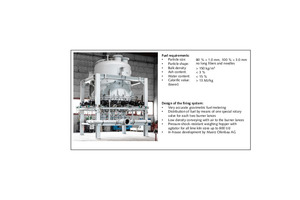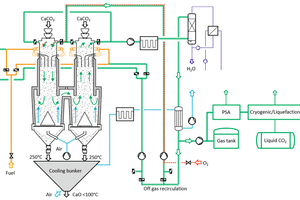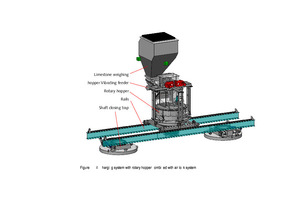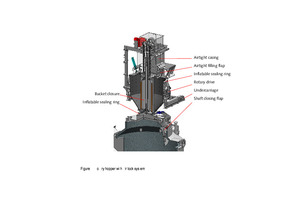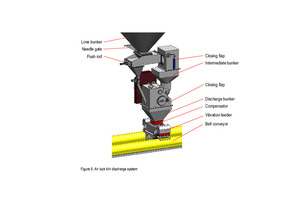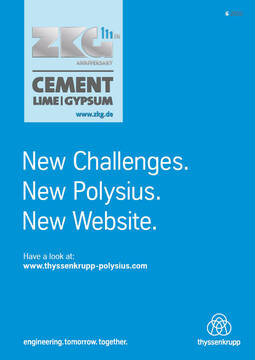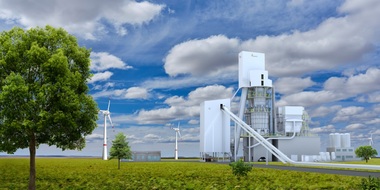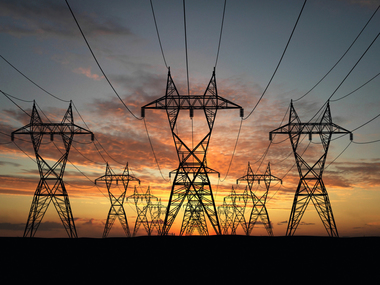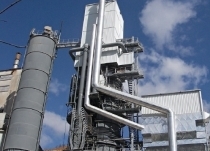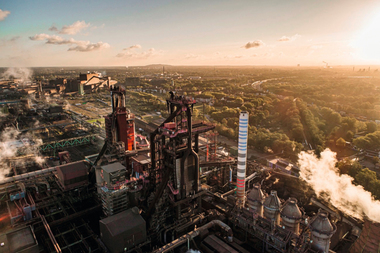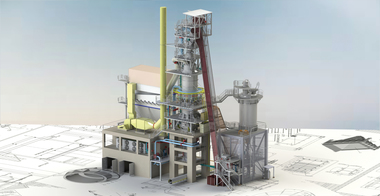Is it sufficient to use renewable energy sources for lime kilns to achieve the climate goals?
The use of biogenic fuels reduces CO2 emissions from PFR lime kilns by around 20%. At first glance, this does not appear to be sufficient to achieve the climate targets. However, this measure can later be combined with a CO2 separation process to further reduce CO2 emissions and it is even possible to achieve a negative CO2 footprint.
Introduction
Climate change is becoming more and more noticeable, which is why global warming should be limited to 1.5 °C as already targeted by the Paris Climate Agreement in 2015. To achieve this goal, we must eliminate all CO2 emissions into the atmosphere by 2050. Since this is not possible in one single step, various procedures and laws have already been put into effect, which now have to be systematically implemented. The industry is facing major challenges: on the one hand, when new plants are built, it must be ensured that the future emission targets are met and, on the other hand, these targets should also be met in the existing production plants. The use of renewable energy sources is a measure that can help to achieve the emission targets.
What are renewable energies?
Renewable energies, also known as regenerative energies, are energy sources that are either available in practically unlimited amounts or can grow back again in a relatively short period of time – in contrast to fossil fuels such as coal or natural gas. Renewable energy sources include hydropower, solar and wind power, and sustainably managed biomass.
Other renewable energy sources are:
Liquid fuels, sustainably produced from biomass
Hydrogen, produced with hydro, solar and wind energy
Fuel gases, produced by fermentation or by pyrolysis of biomass
Using renewable energy sources can reduce CO2 emissions from lime kilns, but is this enough to meet the climate targets?
PFR lime kilns still represent the state of the art when it comes to energy efficiency in the production of high reactive lime. In a natural gas-fired PFR lime kiln, 0.96 t of CO2 are produced for each ton of lime. 20% of this amount comes from burning natural gas and 80% from calcination. When using biogenic or renewable fuels, CO2 emissions are reduced from 0.96 to 0.768 t per t of lime. This is a step in the right direction, leading to a short-term improvement, without the need to invest in a CCUS system immediately. However, in order to reach the final climate targets, the CO2 from calcination will also need to be captured. Another advantage of renewable energy sources is that they create the basis for future CO2-negative lime production. These are important considerations that should be taken into account, as the climate targets must be gradually achieved by 2050. In addition, the sales price for lime must be adjusted to climate-neutral manufacturing processes, and that will take time as well. The transition of the lime industry towards climate neutrality is a complex task, which can be achieved through a wide variety of measures. If they are available, it makes sense to convert existing lime kilns to biogenic fuels now and add a CCUS system later. When building new lime kilns, however, care should be taken to select a kiln type that enables a cost-effective combination with a CCUS system. Possibilities for this have already been published in ZKG 6-2021 [4].
Which biogenic fuels can be used for PFR lime kilns and what are the effects on the burning process?
Compared to the cement industry, the use of biogenic fuels in lime shaft kilns is limited. Sustainable fuels can contain high levels of ash or substances that have a negative impact on lime quality, or pollutant emissions. In contrast to the cement clinker process, the ash components are not bound in the clinker minerals, but they deteriorate the lime quality. There are also other aspects, which need to be considered.
In the case of solid biogenic fuels, the material must be crushed to the required grain size and, depending on the nature of the material, the energy required for this should not be underestimated. Depending on the water content, such fuels must also be dried. If the material is recycled, foreign material such as steel must be removed and harmful components must be burned in the lime kiln for a sufficiently long time at a sufficiently high temperature.
Regarding liquid biogenic fuels, the processing effort is usually limited to good filtration in order to separate any solids that would negatively affect the fuel dosing system. The availability of such fuels is rather limited and the fuels often come from food production, whereby the ethical aspects must also be taken into account. For any future synthetic liquid fuels, the price will probably be too high, making them more viable for aviation. Figure 1 shows the proven “Maerz classic solid fuel dosing system” as an example, which is available for kiln sizes up to 800 t/d.
The use of gaseous biogenic fuels has numerous advantages and should definitely be considered. The biogases listed in Table 3 can be used directly in PFR lime kilns without much effort. With regard to pyrolysis gases, the gases usually contain a high proportion of tar. The tar must be separated beforehand, otherwise the compressor and dosing system would become clogged. Pyrolysis gases sometimes have a fairly low calorific value. With a calorific value of 3.0 to 4.5 MJ/Nm3, a PFR lime kiln could be converted according to [6]. Less effort is required for gases with a calorific value of more than 4.5 MJ/Nm3. In most cases, however, the gases have to be compressed and the fuel dosing systems have to be correctly dimensioned depending on the calorific value. Hydrogen will play an important role in the future and has the advantage that neither CO2 nor pollutant emissions are generated from combustion. Hydrogen can be used in PFR lime kilns without much effort and has no negative effects on the burning process and lime quality.
Taking into account decades of previous experience with PFR lime kilns, Tables 1 to 3 are intended to provide an overview of which biogenic fuels can be used for PFR lime kilns and how their use affects kiln operation, lime quality and pollutant emissions.
What measures are required to achieve economical CO2 separation on existing PFR lime kilns?
To all intents and purposes, an amine scrubber could be installed downstream. However, it must be noted that the energy demand for such a system is very high and the amine process is also sensitive in terms of health issues. The thermal energy requirement for an amine washing system would be about the same as the thermal energy requirement of the lime kiln itself.
For this reason, it could be advantageous to convert existing PFR lime kilns to oxyfuel firing. With the method according to Figure 2, the amount of exhaust gas drops to around 50% and the CO2 concentration in the exhaust gas increases from 20% to almost 45%. This enables the use of a PSA gas separation system combined with a cryogenic system for purification and liquefaction of the CO2. Such a system needs no chemical substances like amines or potassium carbonate, which could create health or corrosion problems. Both the investment and the operating costs of PSA-CRYO systems would be significantly lower than those with an amine scrubber, and both systems are harmless to health.The conversion of the firing process according to Figure 2 requires the following measures:
Installation of an air lock charging system in order to avoid dilution of the kiln off-gas with air. Figures 3 and 4 show an example for round PFR lime kilns. Such a system also allows charging the kiln with two different limestone grain sizes. This optimises the combustion and reduces the formation of CO and NOx [1].
Installation of an air lock discharging system also in order to avoid dilution of the kiln off-gas with air. Figure 5 shows an example, which is applicable to all lime shaft kilns.
Installation of an oxyfuel firing system. A mixture of recirculated kiln exhaust gas and oxygen is used to significantly reduce the nitrogen content in the combustion air. This process has already been published in [5], with the exception that the lime cooling air is not discharged from the kiln here, since existing lime shaft kilns were not designed for this. A high-pressure fan is used to compress the recirculation gases, please refer also to [7].
Since the downstream CO2 capture system requires a continuous flow, a gas tank is needed to bridge the kiln reversal time.
The lance cooling air has to be replaced by recirculated kiln off-gas.
Optionally some of the existing lime kilns can discharge the product at higher temperatures [2] and the final cooling takes place outside of the kiln process in an after cooler. In such a case, the lime kiln would be operated with less lime cooling air, which further increases the CO2 concentration in the kiln off-gases.
What is the best option when a new PFR lime kiln is needed?
For the most cost-effective CO2 separation after the lime kiln, it is advantageous to have the CO2 concentration in the kiln exhaust gas as high as possible. For this reason, the use of a Maerz EcoKiln® [5] or at least Maerz EcoKiln-ready is recommended, which would enable a simple subsequent conversion to oxyfuel firing and cooling air extraction (gas separation in the lime kiln). The second best option would be a PFR lime kiln with oxyfuel firing according to Figure 5.
Summary
Maerz Ofenbau AG has many years of experience in using renewable energies and can offer tailor-made solutions for the lime industry. However, since the sole use of biogenic fuels reduces CO2 emissions by only 20%, Maerz Ofenbau has also developed new lime shaft kilns and processes that enable cost-effective CO2 separation both for new and existing lime kilns. Since the CO2 separation costs decrease sharply with increasing CO2 concentration in the kiln off gas, it is crucial to what extent the CO2 concentration can be increased. Maerz Ofenbau has developed the new Maerz EcoKiln series for new installations, which can be operated with oxyfuel firing and separation of the lime cooling air inside the shaft kiln. However, these lime kilns can also be operated conventionally with air and without cooling air separation. In addition, Maerz has developed a process that makes it possible to operate existing lime kilns with oxyfuel firing, in which case the cooling air is not separated. In both cases, the otherwise required amine scrubbing can be replaced by other processes for final CO2 separation that are harmless to health and significantly less energy-intensive.


